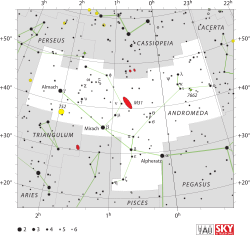Omega Andromedae

| |
| Observation data Epoch J2000 Equinox J2000 | |
|---|---|
| Constellation | Andromeda |
| Right ascension | 01h 27m 39.38177s[1] |
| Declination | +45° 24′ 24.0727″[1] |
| Apparent magnitude (V) | +4.83[2][3] |
| Characteristics | |
| Spectral type | F5 IVe[4] |
| U−B color index | +0.00[3] |
| B−V color index | +0.42[3] |
| Astrometry | |
| Radial velocity (Rv) | +14.7[2] km/s |
| Proper motion (μ) | RA: +356.99[1] mas/yr Dec.: –109.40[1] mas/yr |
| Parallax (π) | 34.94 ± 0.31[1] mas |
| Distance | 93.3 ± 0.8 ly (28.6 ± 0.3 pc) |
| Absolute magnitude (MV) | +2.57[2] |
| Details | |
| Radius | 2.2[5] R☉ |
| Luminosity | 7.1[6] L☉ |
| Temperature | 6,628[6] K |
| Metallicity [Fe/H] | –0.16[2] dex |
| Rotational velocity (v sin i) | 57.1[7] km/s |
| Age | 2.1[2] Gyr |
| Other designations | |
| Database references | |
| SIMBAD | data |
Omega Andromedae (ω And, ω Andromedae) is the Bayer designation for a binary star[8] system in the northern constellation of Andromeda. Based upon parallax measurements made during the Hipparcos mission, this system is located at a distance of approximately 93.3 light-years (28.6 parsecs) from Earth. The apparent visual magnitude of Omega Andromedae is +4.83,[2] which makes it bright enough to be seen with the naked eye.
The primary component of this system has a stellar classification of F5 IVe.[4] The IV luminosity class indicates that it is probably a subgiant star that is in the process of evolving away from the main sequence as the supply of hydrogen at its core becomes exhausted. The measured angular diameter of the primary star is 0.70 ± 0.03 mas.[9] At the estimated distance of this system, this yields a physical size of about 2.2 times the radius of the Sun.[5] It is emitting about seven times the luminosity of the Sun from its outer atmosphere at an effective temperature of 6,628 K.[6] This heat gives it the yellow-white hued glow of an F-type star.[10]
In 2008, the companion star was resolved using adaptive optics at the Lick Observatory. Subsequent observations showed the magnitude difference between the two stars is 3.65 ± 0.03 and they are separated by 0.669 arcseconds.[8]
References
- 1 2 3 4 5 van Leeuwen, F. (November 2007), "Validation of the new Hipparcos reduction", Astronomy and Astrophysics, 474 (2): 653–664, arXiv:0708.1752
 , Bibcode:2007A&A...474..653V, doi:10.1051/0004-6361:20078357.
, Bibcode:2007A&A...474..653V, doi:10.1051/0004-6361:20078357. - 1 2 3 4 5 6 Nordström, B.; et al. (May 2004), "The Geneva-Copenhagen survey of the Solar neighbourhood. Ages, metallicities, and kinematic properties of ˜14 000 F and G dwarfs", Astronomy and Astrophysics, 418: 989–1019, arXiv:astro-ph/0405198
 , Bibcode:2004A&A...418..989N, doi:10.1051/0004-6361:20035959.
, Bibcode:2004A&A...418..989N, doi:10.1051/0004-6361:20035959. - 1 2 3 Johnson, H. L.; et al. (1966), "UBVRIJKL photometry of the bright stars", Communications of the Lunar and Planetary Laboratory, 4 (99), Bibcode:1966CoLPL...4...99J.
- 1 2 3 "LTT 10517 -- High proper-motion Star", SIMBAD Astronomical Object Database, Centre de Données astronomiques de Strasbourg, retrieved 2012-06-26.
- 1 2 Lang, Kenneth R. (2006), Astrophysical formulae, Astronomy and astrophysics library, 1 (3rd ed.), Birkhäuser, ISBN 3-540-29692-1. The radius (R*) is given by:
- 1 2 3 do Nascimento, J. D., Jr.; et al. (July 2003), "On the link between rotation, chromospheric activity and Li abundance in subgiant stars", Astronomy and Astrophysics, 405: 723–731, arXiv:astro-ph/0307196
 , Bibcode:2003A&A...405..723D, doi:10.1051/0004-6361:20030633.
, Bibcode:2003A&A...405..723D, doi:10.1051/0004-6361:20030633. - ↑ Schröder, C.; Reiners, A.; Schmitt, J. H. M. M. (January 2009), "Ca II HK emission in rapidly rotating stars. Evidence for an onset of the solar-type dynamo", Astronomy and Astrophysics, 493 (3): 1099–1107, Bibcode:2009A&A...493.1099S, doi:10.1051/0004-6361:200810377.
- 1 2 Gladysz, Szymon; Christou, Julian C. (June 2009), "Reference-Less Detection, Astrometry, and Photometry of Faint Companions with Adaptive Optics", The Astrophysical Journal, 698 (1): 28–42, arXiv:0805.1870
 , Bibcode:2009ApJ...698...28G, doi:10.1088/0004-637X/698/1/28.
, Bibcode:2009ApJ...698...28G, doi:10.1088/0004-637X/698/1/28. - ↑ Richichi, A.; Percheron, I.; Khristoforova, M. (February 2005), "CHARM2: An updated Catalog of High Angular Resolution Measurements", Astronomy and Astrophysics, 431: 773–777, Bibcode:2005A&A...431..773R, doi:10.1051/0004-6361:20042039
- ↑ "The Colour of Stars", Australia Telescope, Outreach and Education, Commonwealth Scientific and Industrial Research Organisation, December 21, 2004, retrieved 2012-01-16.